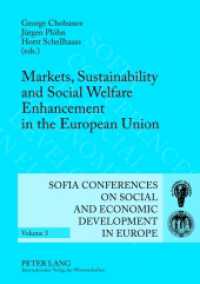- ホーム
- > 洋書
- > 英文書
- > Science / Mathematics
Full Description
This book focuses on the evolution, biogeography, systematics, taxonomy, and ecology of New World and Australasian marsupials, greatly expanding the current knowledge base. There are roughly 140 species of New World marsupials, of which the opossum is the best known. Thanks to recent research, there is now an increasing amount of understanding about their evolution, biogeography, systematics, ecology, and conservation in the Americas, especially in South America. There are also some 270 marsupial species in the Australasian region, many of which have been subject to research only in recent years. Based on this information and the authors' extensive research, this book provides comprehensive insights into the world's marsupials. It will appeal to academics and specialized researchers, students of zoology, paleontology, evolutionary biology, ecology, physiology and conservation as well as interested non-experts.
Contents
Introduction.- Section I. Evolution and Diversification: Checklist of New World Marsupials.- Taxonomy and Diversity of Living New World Marsupials .- Cenozoic Metatherian Evolution in the Americas.- Paleogene Metatherians from the Itaboraí Basin: Diversity, Affinities, and Paleobiogegraphic Context.-Postweaning Skull Growth in Living American and Australasian Marsupials: Allometry and Evolution.- Evolutionary Diversification of Skull Morphology in Faunivorous Marsupials: A Comparison between the American and the Australasian Lineages.- Morphology, Form and Function in Didelphid Marsupials.- Hair Microstructure Diversification in Neotropical Marsupials: the Roles of Phylogenetic Signal and Adaptation.- Patterns of Phenotypic Evolution and Diversification in the Short-Tailed Opossum Genus Monodelphis.- Section II. Biogeography: From Bergmann's to Cope's rules: An Overview on the Trait Variation in New World Marsupials.- A Macroevolutionary Approach to Study the Age-Area Relationships for the New World Marsupials.- An Overview of Species Richness and Beta Diversity Patterns of New World Marsupials.- Diversification of the Didelphid Marsupials of South America..- Diversity and Endemism of Marsupials in the Guiana Region (northeastern Amazonia).- Diversity, Endemism, and Biogeographical History of Marsupials from the South American "Dry Diagonal".- Spatial Patterns and Drivers of Species Richness and Endemism of Marsupials in the Atlantic Forest in eastern South America.- Section III. Ecology: Population Dynamics of Neotropical Marsupials.- More than Semelparity or Iteroparity: Diversity of Reproductive Strategies in New World Marsupials.- Movement Patterns, Habitat Selection, and Home Range of New World Marsupials.- Positional Behavior and Locomotor Performance of New World Marsupials: Links with Habitat and Substrate Use.- Food Habits of New World Marsupials.- Feeding Patterns of Marsupials in a Neotropical Savanna: Intra- and Interspecific Diet Variation and Seasonal Patterns.- Activity Patterns of New World Marsupials.- IV. Conservation.- Conservation Biogeography of Living New World marsupials (Didelphimorphia, Microbiotheria, and Paucituberculata)..- Effects of Habitat Loss and Fragmentation on Assemblages, Populations, and Individuals of New World marsupials.-. Effects of Habitat Loss and Fragmentation per se in Didelphid Marsupials of the Atlantic Forest.- Left Out of the Pouch: Marsupials and the Coverage Provided by Protected Areas in Brazil.-. Unraveling Human-Wildlife Interactions in Urban Areas: the Case of Didelphis aurita in a Large Metropolis.- Habitat Loss, Fragmentation, and Transformation are threatening a Relict Marsupial from Southern South American Temperate Rainforests.- Concluding Remarks.







